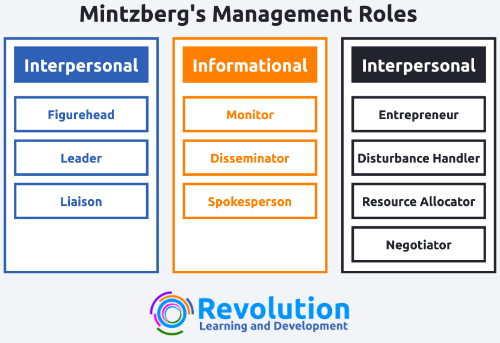What's In this Post
What is Mintzberg’s Management Roles Theory About?
Mintzberg’s Management Roles describes the different roles a manager or leader has.
Managers and leaders have to carry out lots of different tasks. This means they have lots of roles to carry out.
You may find yourself dealing with conflict in the team, having to motivate team members to be more productive, negotiating with senior managers, attending meetings or problem-solving.
Throughout the course of the day, there are probably multiple different tasks you need to carry out, and each one of those tasks requires a different approach to ensure it’s completed quickly and effectively.
To describe what the different parts of a leader or managers role is, Henry Mintzberg said in his book “Mintzberg on Management: Inside our Strange World of Organizations'” that a manager or leader has 10 primary roles or behaviours. These categorise the different roles or functions that a leader or manager has. These are called Mintzberg’s Management Roles.

Mintzberg’s Management Roles Categories
The 10 Management roles are split into 3 different categories:
- Interpersonal – Conversations between 2 or more people
- Informational – Communicating information out to other
- Decisional – Power and confidence to make decisions
Mintzberg’s Management Roles
Interpersonal Roles
- Figurehead – Role modelling the right behaviours that the team should demonstrate. The team will look to the manager or leader of a lead on how to act and behave in the business
- Leader – Providing leadership to the team or other people in the business. This is where you set, monitor and manage performance standards
- Liaison – Communicating in the team and outside of the team. This is about getting to know people in the business and building an effective network
Informational Roles
- Monitor – Observing and overseeing the team, checking performance standards are being met. Looking out for and learning about changes in the business and the industry it sits in to communicate to the team
- Disseminator – Communicating useful and relevant information to the team
- Spokesperson – Communicating information about the team and the business to people outside
Decisional Roles
- Entrepreneur – Creating necessary change in the team and the business. Looking for issues, developing creative ideas to solve them and implementing change successfully
- Disturbance Handler – Cleaning blockages. The leader has a responsibility to facilitate conversations when people disagree or can’t find a way forward
- Resource Allocator – Delegating the right jobs to the people with the right skills and interest for the tasks that need to be completed. This might be providing the right money to projects and the right people for tasks
- Negotiator – Getting involved in negotiations with the team, business and outside parties
Using All of the Roles
The idea behind the model is to think about how much time you spend in each area. We may be guilty of being very comfortable in just a handful of them and neglect the others.
Consider which roles you are good at and which roles need some development. Consider the skills required for each role you need to work on and look at how to develop those skills more. Apply the to develop confidence in those areas and monitor the results. Look for ways to constantly evolve and develop further.
Leadership and Management Training Courses
For more ideas on Leadership and Management techniques, take a look at our Leadership and Management training courses. You can learn more about them on the Leadership and Management training courses page here.

